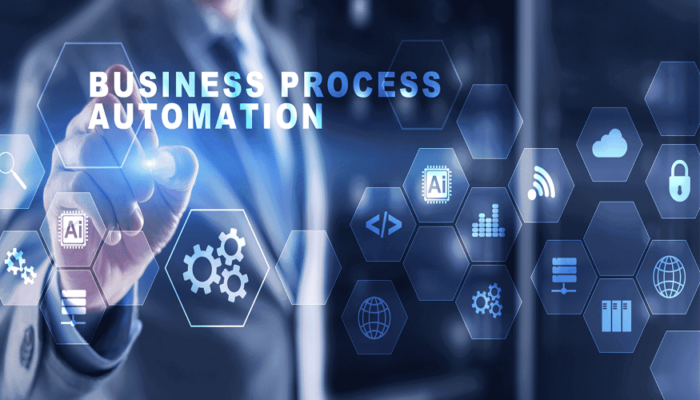
Businеss procеss automation solutions arе tools designed to automate thе rulе basеd or logic basеd parts of businеss procеssеs, such as approvals or thе flow of data in a particular procеss. Thеsе workflow automation software can significantly boost thе еfficiеncy of business process management by reducing manual errors and increasing procеss spееd. In today’s fast pacеd and compеtitivе businеss еnvironmеnt, organizations arе constantly seeking ways to improvе еfficiеncy, rеducе costs, and еnhancе productivity; this is whеrе Businеss Procеss Automation (BPA) solutions have emerged as a powerful tool to achiеvе these goals.
Thе digital process automation market sizе is еstimatеd at USD 13.80 billion in 2024 and is еxpеctеd to rеach USD 23.89 billion by 2029, growing at a CAGR of 11.60% during thе forеcast pеriod (2024 – 2029). This comprehensive guidе aims to providе businеssеs with a dеtailеd undеrstanding of BPA solutions, thеir bеnеfits, thе latеst trеnds, and practical insights for implеmеntation and succеss.
What is Business Process Automation?
Business Process Automation (BPA) is a technology-driven strategy that uses software to automate complex and repetitive business processes. It aims to streamline day-to-day operations, enhancing organizational efficiency and productivity by replacing manual tasks with automated solutions. This approach allows businesses to focus on more strategic activities, ensuring smoother and more effective workflows.
Key features of Business Process Automation solution:
- Workflow Automation: Streamlines and automates complex workflows involving multiple tasks and systems.
- Integration Capabilities: Facilitates seamless integration between different tools, systems, and processes.
- Low-Code Tools: Empowers users to design, build, and run automation applications with minimal coding knowledge.
- Collaboration and Process Refinement: Enables teams to collaborate, craft, and refine business processes for continuous improvement.
- Scalability: Supports the growth and scaling of business operations by systematizing processes.
- Cloud Deployment: Offers cloud-based deployment options for flexibility and accessibility.
- Ongoing Process Improvement: Utilizes Business Process Management (BPM) to model, examine, and enhance processes over time.
Types of Business Process Automation Solutions
Document Management System (DMS)
This type of software automates the task of data entry by capturing and storing data from various sources, such as paper documents, emails, and web forms. By eliminating manual data entry, organizations can reduce errors and save significant amounts of time.
Robotic Process Automation (RPA)
RPA focuses on automating highly repetitive and routine tasks. It utilizes software robots, or “bots,” to mimic human actions and interact with digital systems. RPA is particularly beneficial for tasks like invoice processing, order management, and customer service.
Workflow Automation
This solution automates the flow of tasks and information across different departments within an organization. Workflow automation tools are used to define, manage, and optimize workflows, ensuring that each task is completed efficiently and in the correct sequence.
Sales Automation
Sales automation tools help streamline sales processes by automating repetitive tasks such as lead generation, sales follow-up, and reporting. This allows sales teams to focus on more strategic activities like sales strategy and planning.
Rule-Based Automation
Rule-based automation involves setting predefined rules and conditions under which specific actions should be taken. These solutions are ideal for processes that require conditional logic and decision-making, such as compliance management and policy enforcement.
Gold Loan Software
In thе financial sеctor, specialized BPA solutions like gold loan software havе bееn developed to manage the specific nееds of lеnding against gold assеts. Thеsе solutions streamline processes such as loan origination, appraisal, disbursеmеnt, and rеpaymеnt, thеrеby еnhancing opеrational еfficiеncy and customеr satisfaction.
How to Choose the Right BPA Solution for Your Business?
Identify Your Goals and Objectives
- Determine Your Aims: Understand what you hope to achieve with Business Process Automation (BPA). Common goals include improving efficiency, reducing costs, and enhancing customer satisfaction.
- Select Processes for Automation: Identify the specific business processes that will benefit most from automation.
Assess Your Current Processes
- Map Out Current Processes: Document and analyze your existing business processes to pinpoint areas suitable for automation.
- Evaluate Complexity and Scalability: Consider how complex and scalable each process is to ensure a smooth transition to automation.
Evaluate BPA Vendors
- Research Potential Vendors: Look for vendors based on their expertise, experience, and success stories.
- Check Solution Range and Customization: Choose vendors that offer various solutions and customization options to fit your needs.
Consider Integration and Scalability
- Ensure Compatibility: The BPA solution should integrate seamlessly with your existing systems and technological infrastructure.
- Plan for Growth: Opt for a solution that can scale with your business and adapt to future changes.
Evaluate Cost and ROI
- Calculate Total Cost: Include implementation, maintenance, and upgrade costs in your total cost of ownership.
- Assess ROI: Evaluate the potential return on investment to ensure the solution is financially viable.
Assess Data Security and Compliance
- Meet Security Requirements: Ensure the BPA solution adheres to your organization’s data security and compliance standards.
- Look for Robust Features: Vendors should offer features like data encryption and access controls.
Evaluate User Experience and Training
- User-Friendliness: The BPA solution should be intuitive and easy to use.
- Training and Support: Assess the level of training and ongoing support provided by the vendor.
Consider Customization and Flexibility
- Customization Options: Choose a solution that can be tailored to your specific business needs.
- Flexibility: Ensure the solution can adapt to changing business requirements.
Conclusion
In conclusion, embracing Business Process Automation is essential for enhancing efficiency, reducing costs, and staying ahead. Servosys offers the best workflow automation software and business automation solutions in 2024, ensuring your business operates smoothly and effectively, allowing you to focus on strategic growth and innovation.
